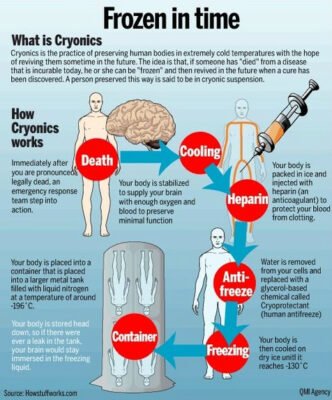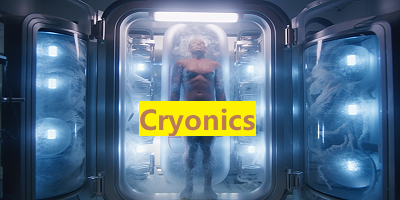AWIP, Ethics, Science & Technology, Technology
Q. Discuss the concept and process of cryonics and evaluate its scientific, ethical, and legal implications. What are the potential benefits and challenges associated with this practice?
Understanding Cryonics
Cryonics is the practice of preserving individuals who have died from a legal and medical standpoint, at very low temperatures, with the hope that future scientific advancements will allow for their revival and restoration to full health. The term originates from the Greek word “kryos,” meaning cold or frost. The fundamental premise of cryonics is that death is a process rather than an event, and that current medical technology may one day advance to a point where conditions currently deemed irreversible can be treated and cured.
Process of Cryonics

- Legal Death Declaration: Cryonics can only be initiated after a person is legally declared dead. This is because current laws do not allow the procedure to be performed on living individuals.
- Cooling and Stabilization: Immediately after legal death is declared, the body is quickly cooled using ice water and certain procedures are performed to maintain blood circulation and oxygenation to protect the brain from damage.
- Cryoprotectant Perfusion: The body undergoes cryoprotectant perfusion, where blood and bodily fluids are replaced with cryoprotectants. These are substances that prevent the formation of ice crystals, which can cause cellular damage during the freezing process.
- Vitrification: Instead of freezing, the body undergoes vitrification, a process where the tissues are solidified into a glass-like state without the formation of ice crystals.
- Storage at Low Temperatures: The vitrified body is then cooled to temperatures of around -196°C (-321°F) using liquid nitrogen and stored in specially designed cryogenic storage tanks.
Implications:
Scientific Implications
The primary scientific premise behind cryonics is that death is a process rather than an event. Proponents believe that future medical technologies might reverse the conditions that led to the individual’s death. However, significant scientific challenges remain:
- Lack of Proven Revival Techniques: There is currently no evidence or methodology for successfully reviving a cryonically preserved body.
- Cryoprotectant Toxicity: Cryoprotectants used to prevent ice formation can be toxic to cells, causing damage.
- Ice Crystal Formation: Despite cryoprotectants, ice crystals can still form, leading to cellular and tissue damage.
- Complex Biological Structures: Preserving and reviving complex structures like the human brain, with its intricate network of neurons and synapses, is particularly challenging.
Ethical Implications
Cryonics raises several ethical issues:
- Consent: Ensuring that individuals have given informed consent for cryonic preservation is crucial. There are concerns about the validity of consent if obtained under distress or without comprehensive understanding.
- Definition of Death: Cryonics challenges the traditional definition of death. If revival becomes possible, it would necessitate a reevaluation of when death actually occurs.
- Equity and Accessibility: Cryonics is expensive and currently accessible only to a wealthy minority. This raises ethical concerns about equity and the potential for socioeconomic disparities in access to life-extending technologies.
- Long-Term Responsibility: Ethical concerns also arise regarding the long-term maintenance of cryonically preserved bodies and the responsibilities of future societies toward them.
Legal Implications
Legally, cryonics presents several challenges:
- Regulation and Oversight: The field of cryonics lacks comprehensive regulation and oversight, leading to concerns about the standards of practice and the protection of individuals’ rights.
- Legal Definition of Death: Cryonics necessitates a reexamination of the legal definition of death. Current laws consider someone legally dead when they cease to exhibit signs of life, but cryonics implies the potential for revival, complicating this definition.
- Contracts and Continuity: Long-term contracts for cryonic preservation must be upheld over potentially centuries, raising questions about their enforceability and the continuity of cryonics organizations.
Potential Benefits
- Life Extension: If successful, cryonics could extend human life significantly, allowing individuals to benefit from future medical advancements.
- Advancements in Medicine: Research into cryonics could drive innovations in related fields, such as cryopreservation techniques for organs and tissues used in transplantation.
- Exploration of Death and Consciousness: Cryonics challenges and expands our understanding of death and consciousness, potentially leading to philosophical and scientific breakthroughs.
Challenges
The ultimate goal of cryonics is to preserve individuals until future technologies and medical treatments are developed to revive and cure them of their fatal conditions. However, cryonics faces several significant challenges:
- Scientific Uncertainty: There is currently no evidence that revival from cryopreservation is possible. The technology and knowledge required to reverse the process and repair any cellular damage do not yet exist.
- Ethical and Legal Issues: Cryonics raises various ethical questions, including issues of consent, the definition of death, and the rights of the preserved individuals. Additionally, current legal frameworks do not support cryonics as a medical procedure for the living.
- Technological Limitations: The current technology for cryopreservation is imperfect. Issues such as ice crystal formation, cellular damage, and the inability to preserve complex structures like the brain with all its memories and personality intact remain unresolved.
- Cost and Accessibility: Cryonics is an expensive procedure, often costing tens of thousands to hundreds of thousands of dollars. This makes it accessible only to a small segment of the population.
Conclusion
Cryonics represents a speculative but intriguing possibility for extending human life and challenging our understanding of death. However, it is fraught with scientific, ethical, and legal challenges that must be addressed before it can be considered a viable practice. The potential benefits are significant, but so are the hurdles that must be overcome to make cryonics a reality.


